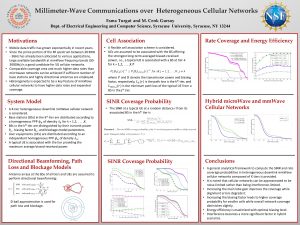MillimeterWave Communications over Heterogeneous Cellular Networks Esma Turgut

- Slides: 1

Millimeter-Wave Communications over Heterogeneous Cellular Networks Esma Turgut and M. Cenk Gursoy Dept. of Electrical Engineering and Computer Science, Syracuse University, Syracuse, NY 13244 Cell Association Motivations • Mobile data traffic has grown exponentially in recent years. • Since the prime portion of the RF spectrum between 30 MHz - 3 GHz has already been allocated to various applications, large available bandwidth at mm. Wave frequency bands (30300 GHz) is a good candidate for 5 G cellular networks. • Comparable coverage area and much higher data rates than microwave networks can be achieved if sufficient number of base stations and highly directional antennas are employed. • Heterogeneity is expected to be a key feature of mm. Wave cellular networks to have higher data rates and expanded coverage. System Model . • A flexible cell association scheme is considered. • UEs are assumed to be associated with the BS offering the strongest long-term averaged biased-received power, i. e. , a typical UE is associated with a BS at tier-k for k = 1, 2, . . . , K if SINR Coverage Probability • The SINR at a typical UE at a random distance r from its associated BS in the kth tier is Directional Beamforming, Path Loss and Blockage Models Antenna arrays at the BSs of all tiers and UEs are assumed to perform directional beamforming: D-ball approximation is used for path loss and blockage. Rate Coverage and Energy Efficiency SINR Coverage Probability Hybrid micro. Wave and mm. Wave Cellular Networks Conclusions • A general analytical framework to compute the SINR and rate coverage probabilities in heterogeneous downlink mm. Wave cellular networks composed of K tiers is provided. • It is noted that cellular networks can be approximated to be noise-limited rather than being interference-limited. • Increasing the main lobe gain improves the coverage while alignment errors degrade it. • Increasing the biasing factor leads to higher coverage probability for smaller cells while overall network coverage diminishes slightly. • Energy efficiency is maximized with optimal biasing level. • Interference becomes a more significant factor in hybrid scenarios.

